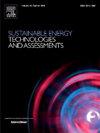Optimal economic model of a combined renewable energy system utilizing Modified
IF 7.1
2区 工程技术
Q1 ENERGY & FUELS
Sustainable Energy Technologies and Assessments
Pub Date : 2025-02-01
DOI:10.1016/j.seta.2025.104186
引用次数: 0
Abstract
In this paper, an optimal solution has been designed for a combined photovoltaic (PV), fuel cell (FC), and wind system. The idea is to manipulate renewable sources to provide clean energy. The main load demand here is supplied by the grid system, and the role of the proposed system is a backup unit. The proposed system has been used to feed the load into a marketplace in Amman Beach, Jordan. The study here aims to the optimal selection of the size of the renewable source to provide minimum total net present cost and to provide a definite number of the drop of energy supply possibility. This study then utilized an improved Metaheuristics algorithm, called Modified Snake Optimization Algorithm to provide an optimization process. A comparison is conducted among the final results of the method and two other methods, including CHS/FA (combined Harmony Search/Firefly algorithm) and PSO (particle swarm optimizer). Simulations are performed assuming a 5.11 MWh average daily load in the research area, 400 kW peak load, and 0.497 loading factor. Simulations show 2 % optimal sizing results for the loss of power supply probability using the proposed MSO algorithm. Changing the grid accessibility ratio from ninety percent (base case) to fifty percent resulted in a growth in the LPSP amount that varies from 3.5 % to 23.5 %. Further, the results show that the cost of energy for the proposed MSO with 0.0461 $/kWh is less than the PSO and CHS/FA. Also, results show better convergence values in 18 iterations than the other algorithms. Experiments showed good efficiency than other comparative methods when it comes to convergence time, system size, and cost of production. Finally, the implementation of the proposed algorithm to optimize the studied hybrid system can achieve superior and competitive results; (e.g, achieving a lower energy cost compared to PSO and CHS/FA algorithms).
求助全文
约1分钟内获得全文
求助全文
来源期刊

Sustainable Energy Technologies and Assessments
Energy-Renewable Energy, Sustainability and the Environment
CiteScore
12.70
自引率
12.50%
发文量
1091
期刊介绍:
Encouraging a transition to a sustainable energy future is imperative for our world. Technologies that enable this shift in various sectors like transportation, heating, and power systems are of utmost importance. Sustainable Energy Technologies and Assessments welcomes papers focusing on a range of aspects and levels of technological advancements in energy generation and utilization. The aim is to reduce the negative environmental impact associated with energy production and consumption, spanning from laboratory experiments to real-world applications in the commercial sector.
 求助内容:
求助内容: 应助结果提醒方式:
应助结果提醒方式:


